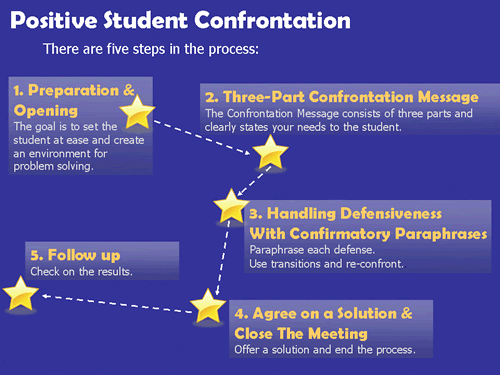Skip navigation
 Positive Student Confirmation Review
Positive Student Confirmation Review

Preparation
- Write out a Three-Part Confrontation Message that accurately describes the situation and your needs.
- Schedule a meeting place that is private. If your room is in an open area, arrange for the use of a closed room.
- Avoid interruptions. Do not take phone calls or see visitors during the meeting.
Opening
- Your goal is to set the student at ease, yet be brief and professional.
- When you set the tone, avoid understatements, such as “I have got a little bit of a problem to discuss,” and overstatements, such as “There’s something going on that’s got to stop right now!”
Three-Part Confrontation Message
- State your needs.
- As you send your Three-Part Confrontation Message, show seriousness in your posture, tone of voice, and inflections. Make eye contact. Make your body language assertive, although not aggressive. Be sure your voice intonation is neutral and not sarcastic.
- Stay focused on the specific situation you’re addressing. Don’t bring up unrelated issues or other difficulties you have with this student.
Discuss and Handle Defensiveness
- Remember that defensiveness isn’t right or wrong; it is just a normal reaction.
- Use a Confirmatory Paraphrase to interpret what a student has said.
- Continue to paraphrase until you get a yes response.
- Use the same basic three-part message when re-confronting. Remember that the student probably has not really heard you. (Emphasize whichever of the three parts of your message has not registered yet.)
Solution and Closing
- Always let the student offer a solution. It may not be what you had in mind, yet it may still meet your needs. If a solution doesn’t meet your needs, say so politely and request others.
- Be aware that “I’ll try” is not a commitment. Mention it and ask for a firm commitment: “You say you’ll ‘try’ _____________. What I need is a firm commitment to this solution.”
- When an acceptable solution is offered, paraphrase it and thank the student.
- Set up a follow-up meeting (four to five days later) to see how the solution is working. Positive body language is important here; this is not a threat.
- End quickly and gracefully by expressing appreciation for the student’s willingness to work out this agreement.
Follow-Up
- Expect lasting change: positive expectations have a powerful effect.
- Acknowledge the desired behavior with appreciation. If there is only partial change, acknowledge that and reaffirm the goal.
- Go for only one change at a time. This will help maintain the relationship and the student’s motivation and cooperation.
Also one change often brings further improvement as an automatic by-product.
- Lasting behavior change takes at least six weeks. Give the student at least this much time before addressing another issue.

More Key Information
 Positive Student Confirmation Review
Positive Student Confirmation Review 

